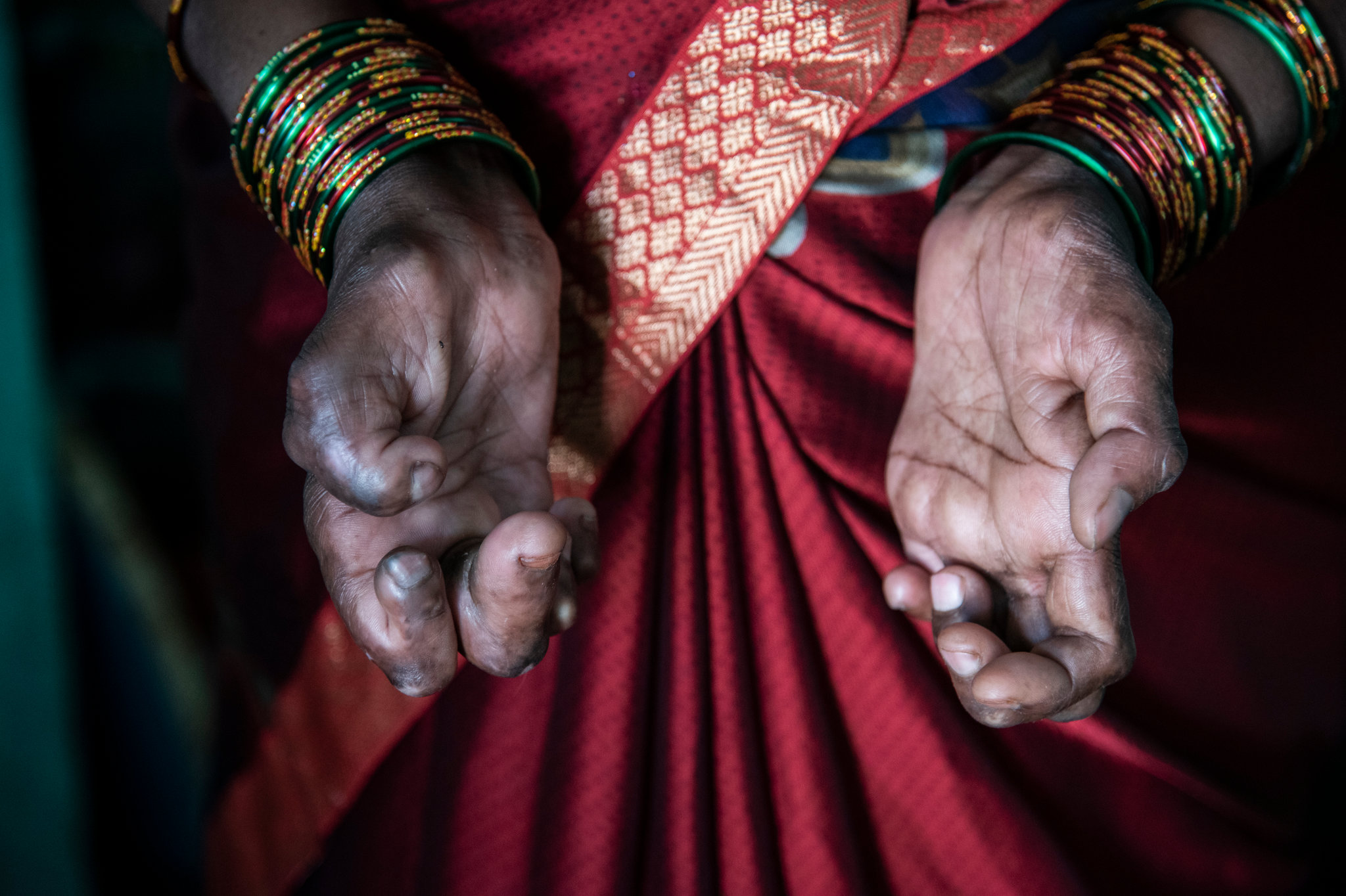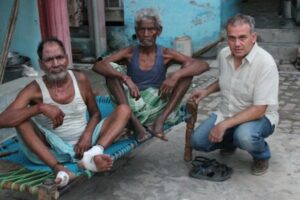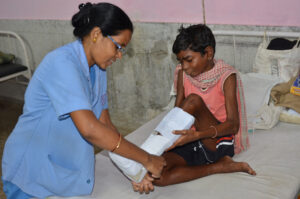Leprosy & stigma: A tough battle to win in India
At the age of 10, Ashok was an ambitious, young boy in Munger, Bihar. He would run for a swim in the Ganges nearby with his friends during the lunch break at school, loved playing sports and was always curious about how electrical appliances or plumbing equipment functioned. One day, during his physical training class in school, his teacher noticed discoloured patches on his back and promptly sent a letter back with Ashok for his father, who worked as a section officer with Indian Railways.
“My entire family started to cry when they read the letter,” says a bespectacled Ashok, who is now 52, sitting in a staircase in the cramped gullies of Kasturba Gram in Delhi, one of India’s 750 leprosy colonies. “My father told me I had kushth rog (leprosy), the disease that the beggars who would come asking for money to our home, with disfigured limbs, had. I was shocked.”
Soon, Ashok was kept in isolation in a room at home. His friends began to avoid him and the holy river that once served as a spot for playful diversions became the place where he would attempt to end his life, before being rescued and taken home by boatmen. He was eventually sent to Titagarh in West Bengal for treatment, where he was cured, and brought to Delhi by a man who promised to find him gainful employment. “He took me to the border on a tricycle, handed me a box, and asked me to go from shop to shop and ask for money,” recalls Ashok. “I refused to beg. I may have had disabilities in my body, but my soul and strength were absolutely fine,” he adds, looking at the deformities on his hands, a result of delayed treatment.
Today, Ashok is a plumber and electrician who works in several schools, offices and homes in Dilshad Garden, and is the vice-president of the Residents Welfare Association of Kasturba Gram, where he lives with his wife and 25-year-old son who is studying to be a radiologist.
But for those like Ashok, years of struggle to reclaim a life interrupted by a dreaded disease is only the beginning of the road to normalcy. Social acceptance is a whole different ball game.
Take the case of Najma from Bareilly, Uttar Pradesh. At the age of 10, she discovered a small perforation under her big toe on her left foot. It got worse, and soon she was unable to walk because her foot turned inwards.
“When people found out I had leprosy, they would tell my brother and sister-in-law to keep my plate and glass away, and to keep me away from them as well,” she says, seated outside her home in Jai Hind, a leprosy colony close to Ashok’s. She travelled to Agra, Chennai, and Delhi for treatment, but a delayed diagnosis has rendered her lame. Her feet are significantly smaller in size, and a few of her toes have been surgically removed. Now 40, she lives with her husband – whom she met at a hospital, and who is also a leprosy-cured person – and her two healthy children – Asha, 20, and Ashraf, 18. She leads a women’s self-help group in the colony and works as a cleaning staff in an office nearby.
Ashok and Najma are among the many leprosy-cured people in India from different backgrounds and with varying levels of disability as a result of the disease. They represent the realities of having combated the disease, picking up their lives, and fighting the odds that society, scriptures and statutes have long held against them.
Elimination is not eradication
Globally, India accounts for 60 pc of all new cases reported annually, with approximately a million new cases between 2016-20, according to the National Leprosy Eradication Programme (NLEP). India figures among 22 nations considered to have a ‘high burden’ of leprosy according to the World Health Organization (WHO).
These statistics may come as a surprise, given the fanfare with which India declared it had eliminated the disease as a public health problem in the year 2005. But that does not mean the disease was eradicated. For reference, India was certified polio-free by the WHO 15 years ago, with no new cases of wild polio reported since January 2011. This is a distant dream as far as leprosy is concerned.
“The WHO benchmark for elimination is that there should be less than 1 case for every 10,000 people. It does not amount to eradication,” says Dr Anil Kumar, deputy director general, NLEP.
The status of elimination also meant that leprosy was integrated with the general healthcare system as opposed to a scheme with its own dedicated funds. With attention and funds shifting to other diseases such as polio and HIV, leprosy remained largely ignored in the country, says Kumar.
“For 10 years until 2005-2006, we had active case detection. After that, it (the number of cases) was almost static. But if you look at the disability cases, the number was increasing,” says Kumar. “This is an indicator of hidden cases.” Self-reporting was often not done, either due to the societal stigma or due to a lack of awareness of its symptoms, he says.
From scriptures to science
Historically, leprosy finds mention in texts dating back to the Atharva Veda in 2000 BC and the Manusmriti in 1500 BC, prohibiting contact with those affected and prescribing punishment for those who married into their families, says Parth Kumar, a junior doctor at Safdarjung Hospital, Delhi and a volunteer at the NLEP, India.
Today, it is known that leprosy is a chronic infectious disease caused by Mycobacterium leprae, found largely in warm tropical regions. It has a high incubation period and, if not diagnosed and treated early, can result in nerve damage, disability, blindness and more commonly in sores and ulcers. These too can be corrected through reconstructive surgery.
As he rightly points out, “This isn’t a disease you can get just through touch.” And since 1984, leprosy has been completely curable at any stage with multi drug therapy (MDT), for a period of six months or one year depending on the severity of the disease.
Leprosy and the law
In spite of these medical advances, India has long had leprosy as a ground for discrimination on its statute books – whether it relates to permitting the segregation and detention of persons affected by leprosy under the now repealed Lepers Act, 1898; personal laws relating to marriage and adoption; or holding positions in public office.
Bijendra, 29, also a volunteer at NLEP, says he was abandoned by his wife when he was diagnosed with leprosy nearly 10 years ago. “Her father told her if she wanted to continue staying with me, they would disown her and that the disease lasts for seven generations in the family,” he says. “They took my son away, filed a dowry case against me, and I even had to go to jail when I couldn’t afford to pay the maintenance,” he adds.
A public interest litigation filed by the Vidhi Centre for Legal Policy has challenged 119 statutory provisions that continue to provide legal sanction to discrimination against people affected by leprosy. Dhvani Mehta, a senior resident fellow at Vidhi, says “People with leprosy are disqualified from being members of academic councils or governing boards in a number of laws relating to statutory universities, holding public office, or contesting local body elections.”
“It is abhorrent to discriminate against a person because of an ailment for which, certainly, he cannot be blamed,” says Mehta. “The term ‘leper’, which continues to be used in the provisions of several central and state enactments, is nothing less than a profanity for people affected by leprosy,” she adds.
Eradicating discrimination is essential
Nikita Sarah, head of advocacy and communication at the Leprosy Mission India, says, “The perception is that if you have leprosy, you end up in the colony. In the 750 colonies or 135,000 new cases, just about 1 pc cases have come from the colonies. The rest are coming from the general community.”
Still, the stigma associated with leprosy runs deep, and getting a celebrity to take up the cause continues to be a challenge. “When you use people with deformity to show work being done to combat leprosy, that is unfair,” Kunju says.
Back in the heart of Delhi’s leprosy colony, Ashok adjusts his bright pink shirt as he gets up to go back home and await his son’s return. “In Bihar and Bengal they would throw away the plate I ate in. They would ask the conductor to throw me out if I sat in a bus,” he says. “In Dilshad garden, wherever I work, there is no hate. They even give me food in their plate at home”, he adds.
He traverses the narrow by-lanes, exchanging greetings with men on donated wheelchairs, and a group playing cards, sprawled on a bedsheet laid out on the side of the road. There’s no sign of the disease in this circle – only cheery smiles as each one hopes to win the next hand. And victory is no stranger to them either. They have all beaten leprosy and the stigma around it.












